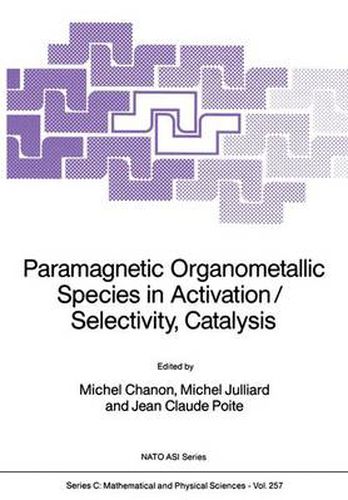Readings Newsletter
Become a Readings Member to make your shopping experience even easier.
Sign in or sign up for free!
You’re not far away from qualifying for FREE standard shipping within Australia
You’ve qualified for FREE standard shipping within Australia
The cart is loading…






When one considers the overall representation of frontier orbital filling of hexacoordinate (Oh) and tetracoordinate (Td) inorganic and organo metallic complexes, it clearly appears that out of 26 cases covering both high spin and low spin situations, 21 represent paramagnetic species (K. Purcell, J. Kotz, Inorganic Chemistry , Saunders, 1977, p561). This would suggest that, if there is a part in chemistry to illustrate the reactivity of radical species, this part certainly is inorganic organometallic chemistry. In contrast with these expectations, and whereas the standard Organic Chemistry textbook (J. March , Advanced Organic Chemistry , J. Wiley, N. Y. , 1985) has a specific chapter devoted to free radical reactivity, neither the inorganic standard (FA Cotton, G. Wilkinson, Advanced Inorganic Chemistry , Wiley, 1988), nor the Organometallic one (J. P. Collman, L. S. Hegedus, J. R. Norton, R. G. Finke, Principles and Applications of Organotransition Metal Chemistry , University Science Books Mill Valley C. A. , 1987) possess such a specific chapter. The balance is partly restored because the two last cited books have a more comprehensive treatment of electron transfer phenomena. These comparisons show unambiguously that the importance of paramagnetic species in chemical reactivity still lacks a consistent treatment transcending the artificial barriers between branches of Chemistry. This book, which brings together experimental facts and concepts originating from organometallic and organic reactivities, is a step in the direction of bridging this gap. The unifying thread which connects the 35 chapters throughout this book is Activation/Selectivity and Catalysis by means of radical chemistry.
$9.00 standard shipping within Australia
FREE standard shipping within Australia for orders over $100.00
Express & International shipping calculated at checkout
When one considers the overall representation of frontier orbital filling of hexacoordinate (Oh) and tetracoordinate (Td) inorganic and organo metallic complexes, it clearly appears that out of 26 cases covering both high spin and low spin situations, 21 represent paramagnetic species (K. Purcell, J. Kotz, Inorganic Chemistry , Saunders, 1977, p561). This would suggest that, if there is a part in chemistry to illustrate the reactivity of radical species, this part certainly is inorganic organometallic chemistry. In contrast with these expectations, and whereas the standard Organic Chemistry textbook (J. March , Advanced Organic Chemistry , J. Wiley, N. Y. , 1985) has a specific chapter devoted to free radical reactivity, neither the inorganic standard (FA Cotton, G. Wilkinson, Advanced Inorganic Chemistry , Wiley, 1988), nor the Organometallic one (J. P. Collman, L. S. Hegedus, J. R. Norton, R. G. Finke, Principles and Applications of Organotransition Metal Chemistry , University Science Books Mill Valley C. A. , 1987) possess such a specific chapter. The balance is partly restored because the two last cited books have a more comprehensive treatment of electron transfer phenomena. These comparisons show unambiguously that the importance of paramagnetic species in chemical reactivity still lacks a consistent treatment transcending the artificial barriers between branches of Chemistry. This book, which brings together experimental facts and concepts originating from organometallic and organic reactivities, is a step in the direction of bridging this gap. The unifying thread which connects the 35 chapters throughout this book is Activation/Selectivity and Catalysis by means of radical chemistry.